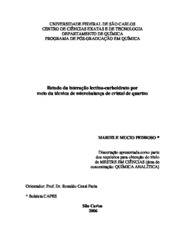| dc.contributor.author | Pedroso, Mariele Mucio | |
| dc.date.accessioned | 2016-06-02T20:36:12Z | |
| dc.date.available | 2008-08-19 | |
| dc.date.available | 2016-06-02T20:36:12Z | |
| dc.date.issued | 2006-10-20 | |
| dc.identifier.citation | PEDROSO, Mariele Mucio. The study of the lectin-carbohydrate interaction Using the quartz crystal microbalance technique. 2006. 112 f. Dissertação (Mestrado em Ciências Exatas e da Terra) - Universidade Federal de São Carlos, São Carlos, 2006. | por |
| dc.identifier.uri | https://repositorio.ufscar.br/handle/ufscar/6396 | |
| dc.description.abstract | In this work a study of proteins Jacalin and Concanavalin A, belonging to the class of lectins, and the interaction with different carbohydrates was accomplished through Quartz Crystal Microbalance (QCM). The lectins were immobilized by self-assembly monolayer by means three methods. In two of them were used the cystamine and glutaraldehyde and the protein immobilized in a single layer or multilayer. In the third method, a solution of thiols, 11-mercaptoundecanoic acid and 2-mercaptoethanol, in a proportion of 1:10, and the reagents reagents Nethyl- N-(dimethylaminopropyl) carbodiimide (EDC) and N-hydroxysuccinimide (NHS) were used to formed a intermediated reactive to binding a protein of interest. Significant differences were not observed among the methods, being opted for the lectins immobilization in a single layer using cystamine and glutaraldehyde due to the simple preparation and low consumption of reagents. The formation of self-assembly monolayer formation was studied using the Electroacoustic Admittance, QCM and a flow injection system coupled to QCM. In all studies a cystamine concentration of 15 mmol. L-1 produced the highest frequency variation and therefore the largest observed mass deposition on the gold surface with good repetitivity. However, it was observed a strong interaction between the free cystamine and to that was binding to the gold surface forming a monolayer, but this interaction was not specific. The flow injection system coupled to the QCM technique was also used to study the interaction between the lectin-carbohydrate and lectin-glicoconjugate. This study allows determining that the variation of the quartz crystal frequency was the same magnitude that observed for a system when using a QCM technique. The Langmuir adsorption isotherm was used to calculate the values of the apparent affinity constant for the lectins with different ligands. The apparent affinity constant was 1.4x105 M-1, 9.4x103 M-1 and 5.6x102 M-1 for Jacalin- Fetuin, Jacalin-Galactose and ConA-Maltose interactions respectively. The determinations of the apparent affinity constants using QCM, demonstrated the viability of the technique in the study of molecular interactions. | eng |
| dc.description.sponsorship | Financiadora de Estudos e Projetos | |
| dc.format | application/pdf | por |
| dc.language | por | por |
| dc.publisher | Universidade Federal de São Carlos | por |
| dc.rights | Acesso Aberto | por |
| dc.subject | Química analítica | por |
| dc.subject | Microbalança de cristal de quartzo | por |
| dc.subject | Lectina | por |
| dc.subject | Monocamadas auto-organizadas | por |
| dc.title | Estudo de interação lectina-carboidrato por meio da técnica de microbalança de cristal de quartzo | por |
| dc.title.alternative | The study of the lectin-carbohydrate interaction Using the quartz crystal microbalance technique | eng |
| dc.type | Dissertação | por |
| dc.contributor.advisor1 | Faria, Ronaldo Censi | |
| dc.contributor.advisor1Lattes | http://lattes.cnpq.br/8659496864305621 | por |
| dc.description.resumo | Neste trabalho realizou-se o estudo das proteínas jacalina e concanavalina A, pertencentes à classe das lectinas, e suas interações com diferentes carboidratos, por meio da técnica de microbalança de cristal de quartzo (QCM). As lectinas foram imobilizadas por meio da técnica de monocamadas auto-organizadas utilizando-se três métodos. Dois deles foram realizados com cistamina e glutaraldeído, sendo a proteína imobilizada em uma única camada ou em multicamadas. No terceiro método, uma solução contendo dois tióis, ácido 11- mercaptoundecanóico e 2-mercaptoetanol, na proporção de 1:10, e os reagentes N-etil-N-(dimetilaminopropil) carbodiimida (EDC) e N-hidoxisuccinimida (NHS) foram utilizados para formar um intermediário reativo susceptível ao acoplamento com a proteína de interesse. Não foram observadas diferenças significativas entre os métodos, optando-se pela imobilização das lectinas em uma única camada de cistamina e glutaraldeído, pela facilidade no preparo e baixo consumo de reagentes. A formação da monocamada de cistamina foi estudada utilizando-se as técnicas de admitância eletroacústica, QCM e um sistema de injeção em fluxo acoplado à QCM. Em todos os estudos uma concentração de cistamina de 15 mmol. L-1 apresentou melhor recobrimento da superfície do cristal de quartzo com melhor repetibilidade. Entretanto, foi observado uma forte interação da cistamina livre com àquela que estava ligada à superfície do ouro formando a monocamada, mas esta interação não foi específica. O sistema de injeção em fluxo acoplado à microbalança de cristal de quartzo também foi utilizado para estudar a interação lectina-caboidrato e lectina-glicoconjugado. Este estudo permitiu determinar que a variação na freqüência de oscilação do cristal de quartzo foi da mesma magnitude que a observada para o sistema sem injeção em fluxo. O modelo de adsorção da isoterma de Langmuir foi empregado para calcular os valores das constantes de afinidade aparente para as lectinas com diferentes ligantes. As constantes de afinidade calculadas foram 1,4 x 105 M-1 e 9,4 x 103 M-1 e 5,6 x 102 M-1 para interações jacalina-fetuína, jacalina-galactose e ConA-maltose. As determinações das constantes de afinidade aparente utilizando-se a técnica de QCM demonstram a viabilidade da técnica no estudo de interações moleculares, como a das lectinas com carboidratos. | por |
| dc.publisher.country | BR | por |
| dc.publisher.initials | UFSCar | por |
| dc.publisher.program | Programa de Pós-Graduação em Química - PPGQ | por |
| dc.subject.cnpq | CIENCIAS EXATAS E DA TERRA::QUIMICA | por |
| dc.contributor.authorlattes | http://lattes.cnpq.br/9851115714877073 | por |
